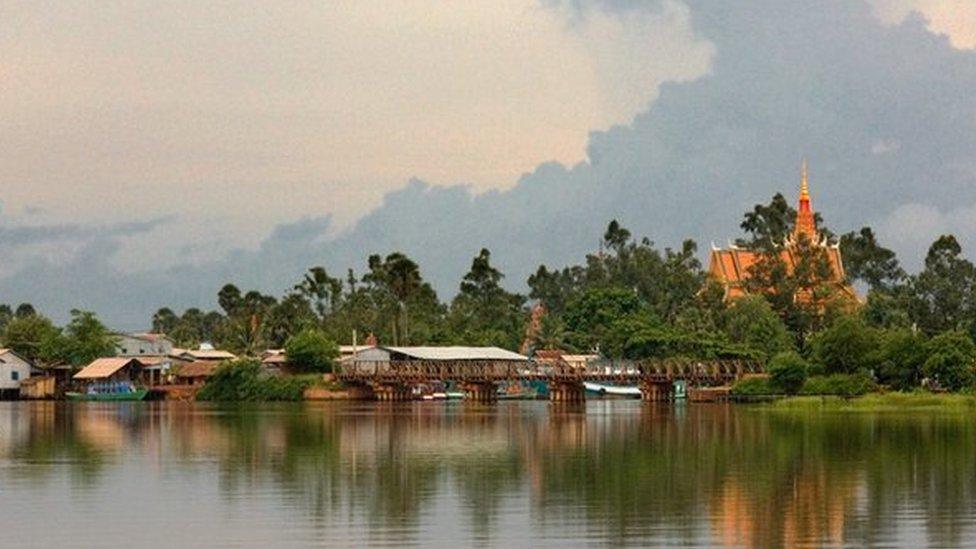Aung San Suu Kyi's Myanmar dam dilemma with China
- Published
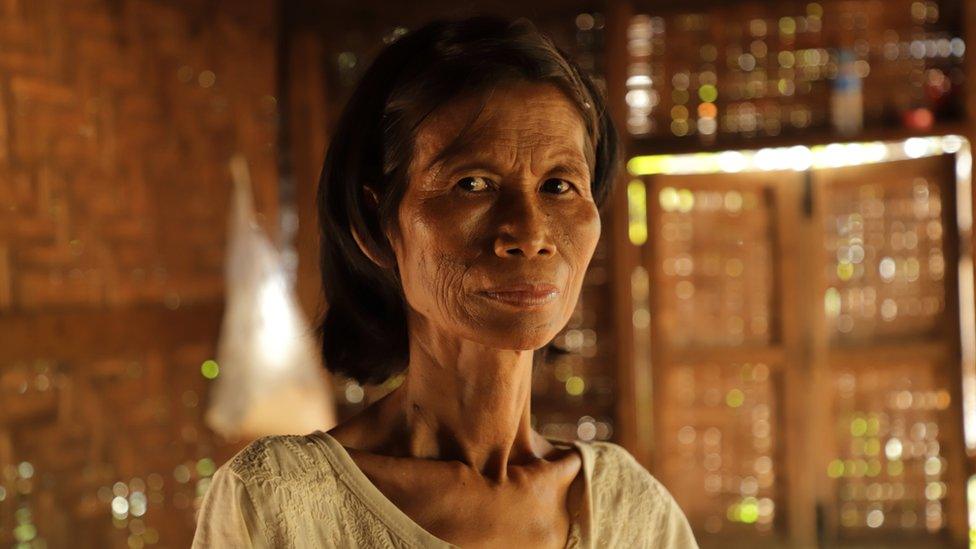
Jar Lie was forced to leave her 40 acres of farming land to make way for the dam
In 2011, construction work on a massive dam project in Myanmar's restive Kachin state was halted after large protests. China is now lobbying hard for the work to resume, but as BBC News Burmese's Soe Soe Htoon found, local people are still not convinced they will ever see its benefits.
"I always cry every time I talk about the dam," says Jar Lie.
Eight years ago, she was forced to abandon her 40 acres of farmland and move to a resettlement village in Aung Myin Tha, around six miles (nine kilometres) away.
Her land was to be flooded by the vast reservoir created by the $3.6bn (£2.8bn) Chinese-financed Myitsone dam, at the source of the Irrawaddy river. Her new village has a market, a hospital, sealed roads and a school, all provided by the company building the dam, Beijing's State Power Investment Corporation (SPIC).
But Jar Lie says that without farming land, life here is very difficult.
"We could eat what we grew before; there was no need to buy anything. Here without land we can't do anything; we don't know how to earn money. I am very sick here."
The dam was due to be completed this year - but so far work has barely begun, and the project has exposed simmering tensions over the balance of power between China and the country it often refers to as its younger brother.
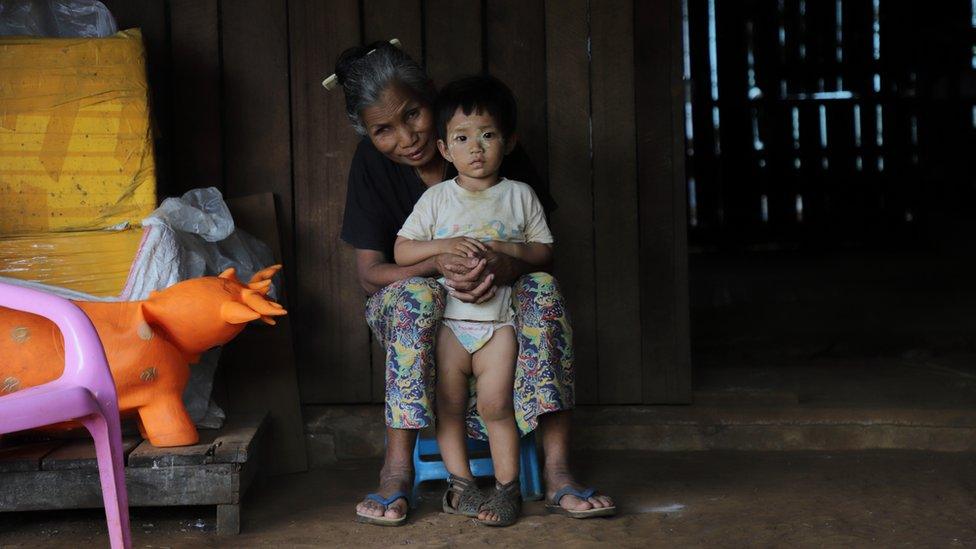
Jar Lie's family says life is tough without farming land
The Myitsone was to be the largest of seven dams SPIC is promising to build in the region, to provide quickly-developing Myanmar with much-needed electricity.
By some estimates, the project would by itself generate more energy than the entire country produces now.
The full contract the former military government signed with SPIC has never been publicly released. But in a rare interview in May, with BBC News Burmese, the former deputy minister of Myanmar's state power company, U Maw Thar Htwe, confirmed the most provocative part of the deal - that 90% of the electricity the dam generated would go back over the border to China.
According to U Maw Thar Htwe, the government will get a 10% stake in the dam but will only see a return on its investment two decades after it starts operations.
'The dam will kill the river'
From the start there have been questions over whose interests the dam would actually serve.
The Irrawaddy is often described as the lifeblood of Myanmar, and the Myitsone area is believed to be the birthplace of the Kachin people, after whom the state is named.
Since 1962, ethnic Kachin rebels have been fighting the Burmese military for greater control over the resource-rich region.
It is one of the world's longest-running civil wars, and Kachin independence leaders viewed the dam as a direct threat to their people and their livelihoods.
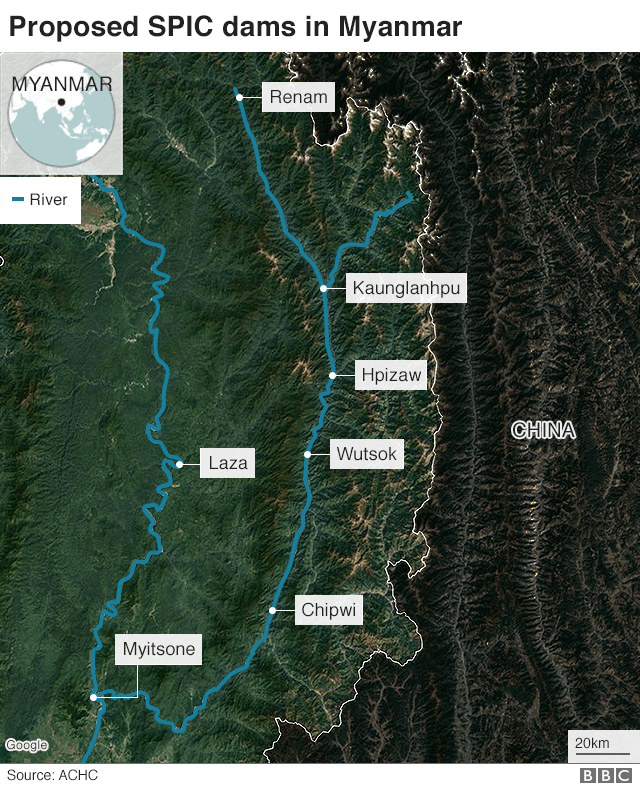

The dam, which would be one of the largest in the region, would displace thousands more people - and environmentalists warn it would flood an area the size of Singapore.
"We are going to lose this critical watershed area for the Irrawaddy river and flood some of our last remaining forests - dense jungle that holds rich biodiversity," says environmentalist Dr Myint Zaw.
"The dam will most likely kill the river," he warns.
"It will have a huge downstream effect, changing the tides of the river and affecting the livelihoods of millions of fishermen."
In 2011 widespread protests broke out against the dam. Outside Myanmar, activists from both environmental and human rights groups threw their weight behind the campaign, and in a rare concession to people power the Myanmar central government put the project on hold.
No major work has happened on it since.
A government commission into the fate of the project was formed in 2016 and submitted its final report to the president's office in November last year. But the government has never published the findings, and rumours abound.
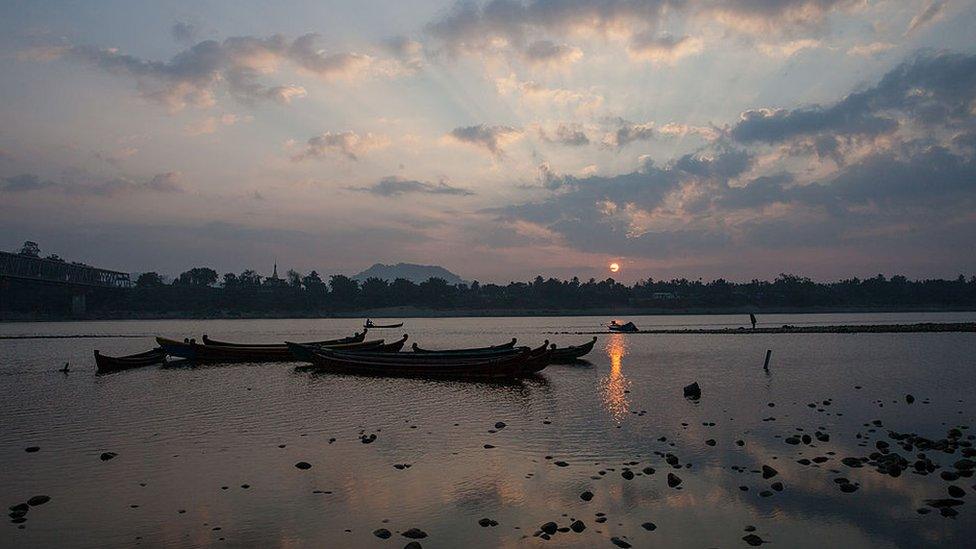
The Irrawaddy is often referred to as the lifeblood of the country, supporting millions of fishermen
Now eight years after it was halted, China has stepped up efforts to convince local residents and officials to support it.
China's former ambassador to Myanmar, Hong Liang, visited the area in December last year and claimed afterwards that the Kachin people did not oppose the resumption of the dam.
In a statement, he blamed outsiders for causing the opposition movement against it, something Kachin leaders who met him later stronger denied.
Then in June, a group of Chinese experts tried to reassure lawmakers in the Kachin parliament about the dam's environmental impact.
In a written statement to BBC News Burmese, SPIC said the purpose of the dam was to "provide clean, efficient and sustainable power supply for Myanmar's development".
In a hint that it believes the project will be unfrozen, the company said it believes a "fair and objective decision" will be made.
"The Myitsone Hydropower Project has been strictly examined and approved by the governments of Myanmar and China," it stated.
'We need to keep our promises'
When she was in opposition, Aung San Suu Kyi spoke out against the dam. But since becoming Myanmar's de facto leader after the historic elections in 2015, she has changed her view.
She has said deals struck under the former military government should be honoured.
Speaking at a public forum earlier this year she made a rare comment about the dam, saying: "For the dignity of our country, and for our country to be trusted in the world, we will need to keep our promises."
"We cannot do whatever we like to the big projects that have started in the past because we are in power now. If we do that, our country will be seen as unreliable. If the world does not want to work with us, then it will have a big impact on our country."
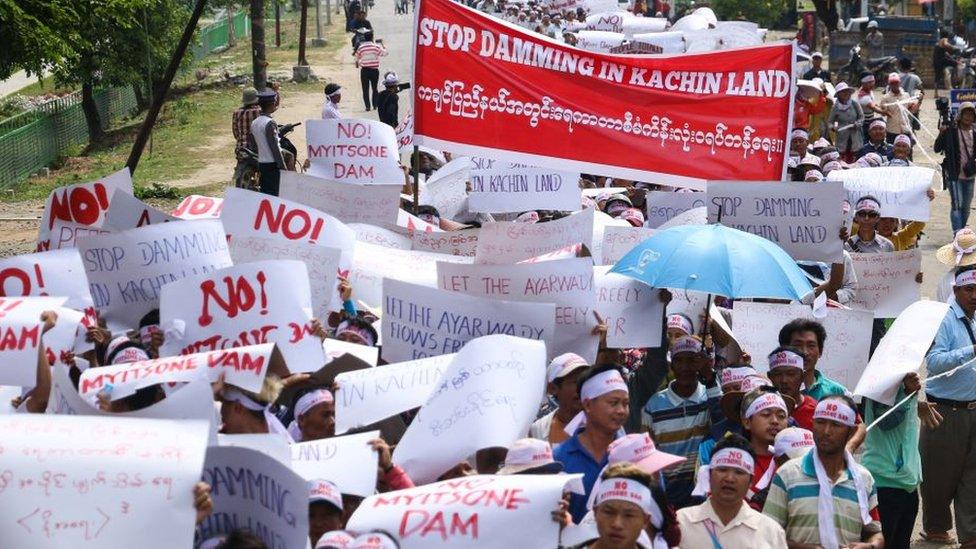
Protests in April in the Kachin state against the resumption of the controversial mega project
Fears the project will be revived have sparked a new wave of protests.
In late April, as Aung San Suu Kyi was in Beijing for a summit on Chinese foreign investment, thousands took to the streets back home demanding the dam be scrapped for good.
But analysts say she faces a dilemma.
She needs to establish prosperity and peace if she is to convince the Burmese people of the benefits of democracy, and reliable electricity will be part of that. But she also needs to convince them she's not selling off the country.
And Myanmar needs China.
China has far-reaching influence as a major investor and trading partner, and it is also playing a key role in peace talks with armed ethnic groups along its border with Myanmar.
"There is very widespread opposition to the dam, but China's role in Myanmar is so wide and significant, so they need to consider all these elements," says analyst Khun Htoi who closely studies China-Myanmar relations.
"They [China] are the redeemer of Myanmar in front of the international community, and they are the biggest investor in the country. Without their investment it's questionable whether Myanmar can go on or not."
And if the government cancels the project outright, it could have to repay some $800m that the state-owned Chinese developer says it has already invested.
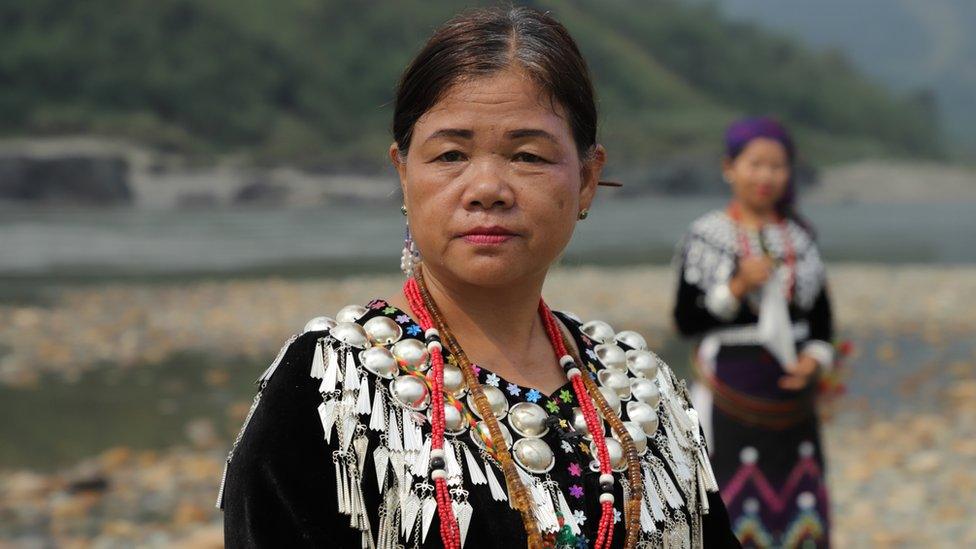
Lu Ra says the Myitsone is the ancestral birthplace of her people
In a sign of the influence of social media in Myanmar, a crowdfunding campaign has been set up by a group of prominent activists and artists asking people to donate $1 each to pay back China to abandon the dam.
"I want to take back Myitsone, no matter what. Myitsone was sold on paper only without giving us any notice or say. So, for the stake of future generations, we want to compensate China," says Juu, the writer behind the campaign.
Despite some high-profile backers, the campaign hasn't taken off, with other activists criticising the movement as a token gesture that wasn't realistic.
'Let the river flow freely'
For the local people of Kachin, this is about more than the economics.
On the banks of the river, local singer Lu Ra stands in the water, running her toes through the pebbles.
Around her, Myanmar tourists who paid a small amount of money to hire local Kachin traditional dress from stalls above the river, take photos. Buddhist monks have come here to bathe and take photos of this picturesque area.
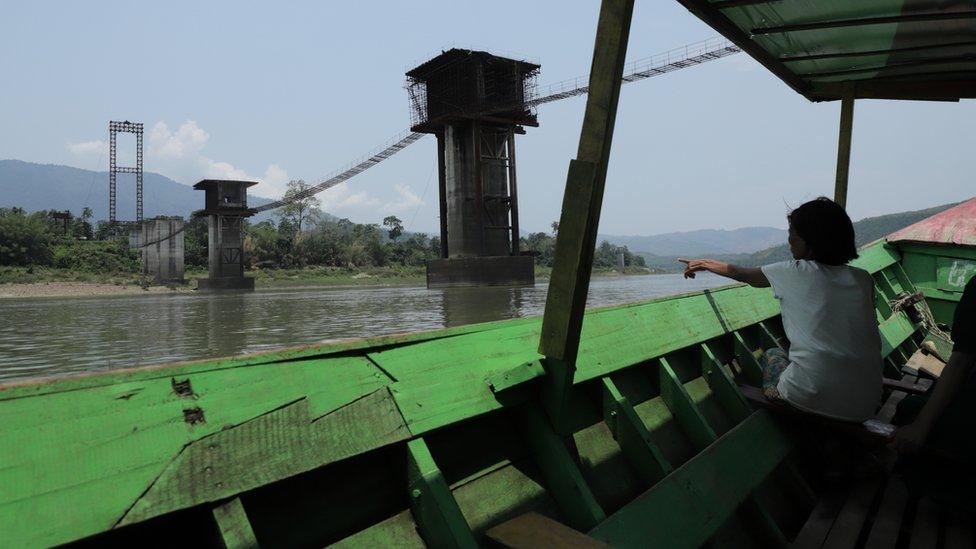
Jar Lie points at where she used to live.
"Look at this beautiful place, the river, the forests and the mountains," Lu says, looking across at the peaks circled in white clouds.
"If this dam project is built, we won't see this landscape anymore. We are saying please don't build it, just let the Irrawaddy river flow freely forever. We have a duty to protect it."
Our request to visit the dam site was turned down, so we travelled by boat with Jar Lie past the land that used to be hers.
In the middle of the river, we pass under the giant pillars of an unfinished bridge which is part of the dam project, a symbolic reminder for the local people of the fate hanging over their future.
When the boat engine starts failing we drift towards shore - but a company security guard comes rushing down and orders us to leave the area.
Jar Lie points through tears at where she once lived as the boat slowly moves away.
"These are my lands but I am not allowed by the company to step onto my land, or even collect plants or herbs," she says.
"I won't come back and see this area again. It's too painful to see it but not be able to walk on it."
Photos by Phyo Hein Kyaw
- Published20 April 2019
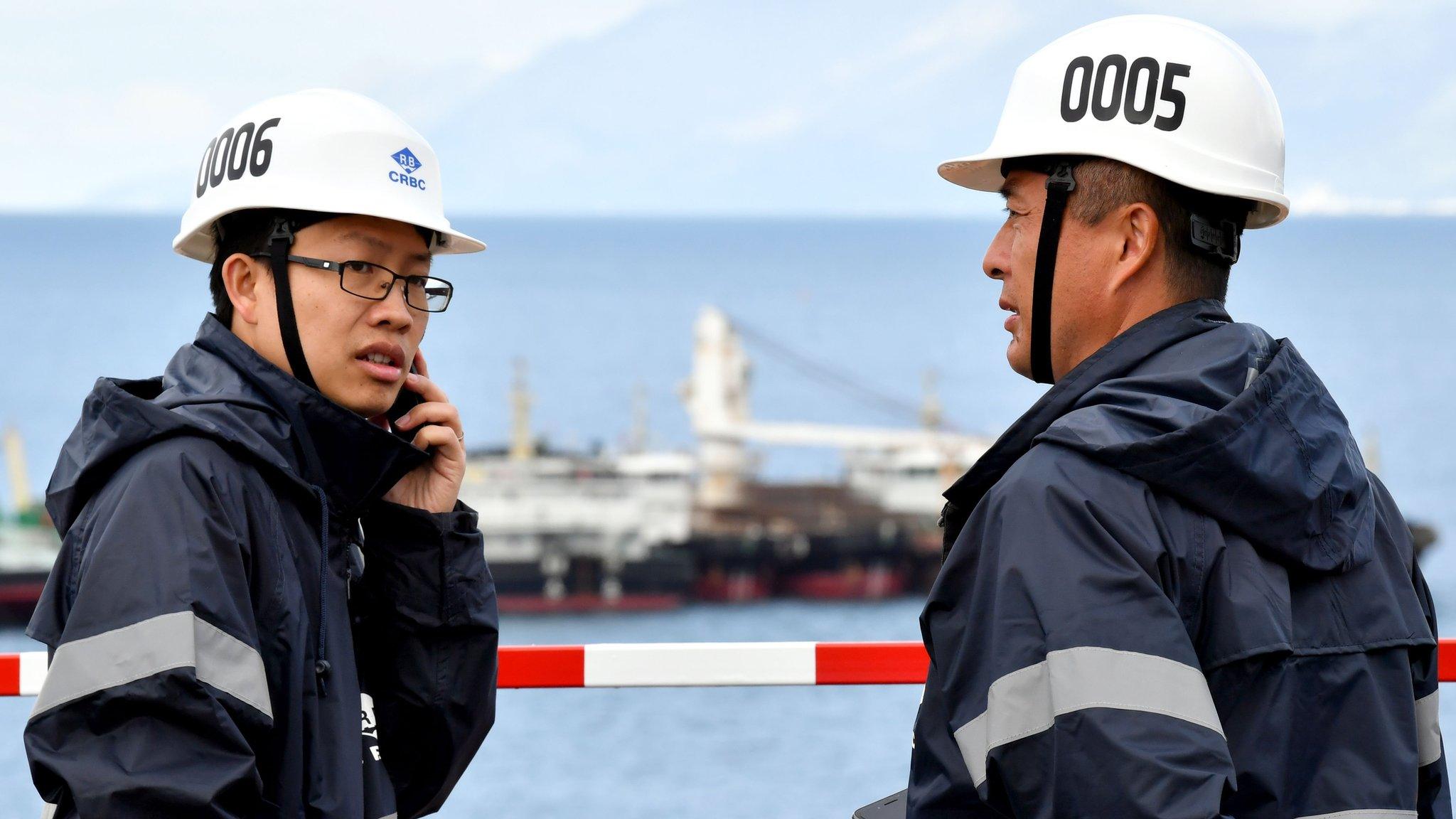
- Published27 June 2019

- Published5 November 2018
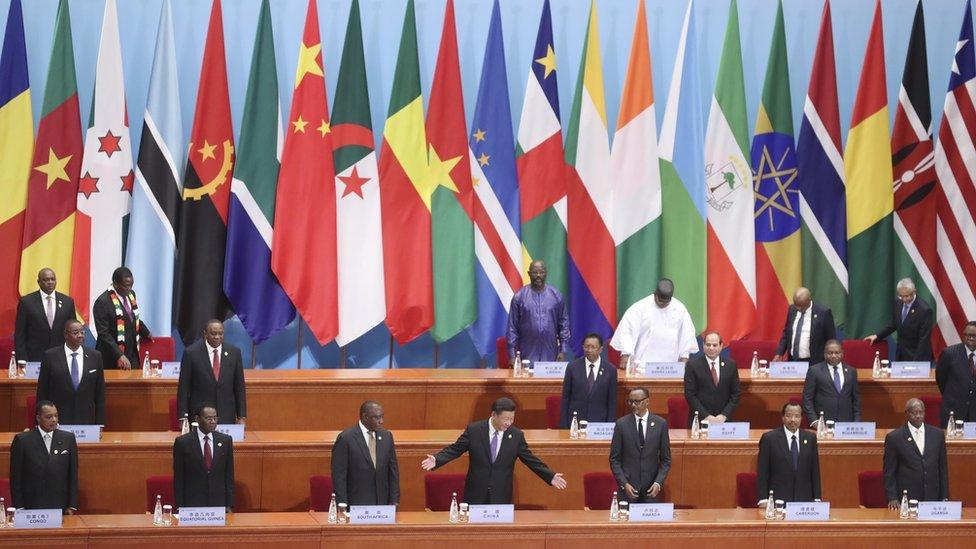
- Published16 September 2018
